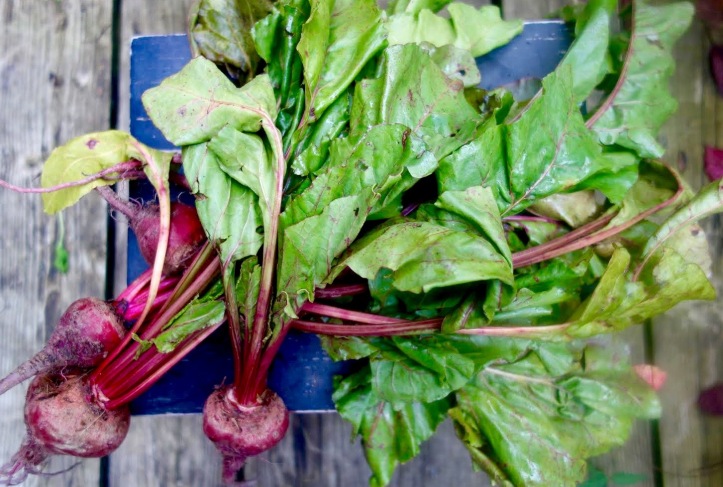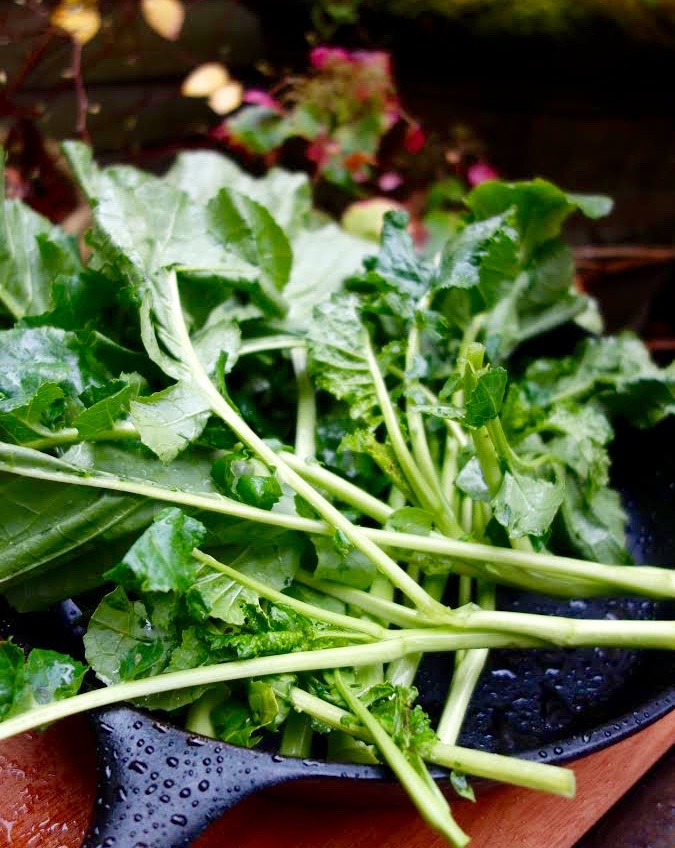Arugula

 Arugula, also known as rocket, is a peppery-tasting green native to the Mediterranean where is grows wild from Portugal’s shores to inland Turkey. Its refreshing bite and delicate leaves make it a culinary favorite. An excellent source of Vitamins K, A, C and folic acid, arugula also contains essential minerals including, potassium, iron, calcium, manganese, zinc, copper and magnesium.
Arugula, also known as rocket, is a peppery-tasting green native to the Mediterranean where is grows wild from Portugal’s shores to inland Turkey. Its refreshing bite and delicate leaves make it a culinary favorite. An excellent source of Vitamins K, A, C and folic acid, arugula also contains essential minerals including, potassium, iron, calcium, manganese, zinc, copper and magnesium.
This green may be grown as an annual or a perennial. Give it a try in a tub on your porch–only 30-40 days growing time when planted in the spring or fall (a cool season crop). Wild arugula, pictured here and sold by the bunch, can take some stove or oven heat with the coarse outside leaves holding up to a braise. For salads, I choose the smaller leaf arugula that is bright green, sold in a tub. Go Girl Organic is my brand in Seattle. In a plastic clamshell, these serrated delicate leaves will last for over a week. Once they yellow, they are ready for the compost bin. But save that tub– it makes a great organizer that keeps bits of vegetables fresh for a week!!
Beet Greens

 Beet greens are in the same family as Swiss chard, and their edible leaves are somewhat similar in taste with their veining reflecting the color of the beet root. Beet greens are one of the ten highest ranked foods by the Healthiest Foods on Earth website (with 3.5 million annual viewers, it’s a great resource for nutrition). Beet greens rank high in all nutrient categories: micronutrients, vitamins, and minerals.
Beet greens are in the same family as Swiss chard, and their edible leaves are somewhat similar in taste with their veining reflecting the color of the beet root. Beet greens are one of the ten highest ranked foods by the Healthiest Foods on Earth website (with 3.5 million annual viewers, it’s a great resource for nutrition). Beet greens rank high in all nutrient categories: micronutrients, vitamins, and minerals.
These greens also provide excellent amounts of calcium and magnesium, which is important since more U.S. adults are deficient in magnesium than calcium. Beet greens are an excellent source of fiber and a very good source of protein. They are an excellent source for Vitamin A because of high levels of beta-carotene and lutein.
Broccoli Rabe
 Broccoli Rabe (also Raab) is a leafy brassicas which is part of the mustard family, like kale, Brussels sprouts, mustard greens, and arugula. Although the buds on this plant look like broccoli, they don’t form into large heads and it is quite distinguishable in appearance and taste. While the broccoli leaves are almost nonexistent, it is the leaves on rabe that compromise most of this versatile pungent and highly nutritious vegetable (the stems and florets are also edible). Making regular appearances in upscale raviolis, and chopped finely in our new PCC favorite chicken sausage (labeled as chicken-rapini), broccoli rabe’s bitter taste and textured leaves hold up to sauces and sautés very nicely. It is common in dishes from Southern Italy, Portugal, and in the Galicia region of Spain. Laura Russell pairs a lovely Romesco sauce with hers.
Broccoli Rabe (also Raab) is a leafy brassicas which is part of the mustard family, like kale, Brussels sprouts, mustard greens, and arugula. Although the buds on this plant look like broccoli, they don’t form into large heads and it is quite distinguishable in appearance and taste. While the broccoli leaves are almost nonexistent, it is the leaves on rabe that compromise most of this versatile pungent and highly nutritious vegetable (the stems and florets are also edible). Making regular appearances in upscale raviolis, and chopped finely in our new PCC favorite chicken sausage (labeled as chicken-rapini), broccoli rabe’s bitter taste and textured leaves hold up to sauces and sautés very nicely. It is common in dishes from Southern Italy, Portugal, and in the Galicia region of Spain. Laura Russell pairs a lovely Romesco sauce with hers.
 If you want to reduce some of the bitterness (I never do!) blanch the rabe for a few minutes and let drain, but don’t cook very long and make sure the water is removed. I plate it sautéed under savory meats with roasted or caramelized vegetables. Or maybe your go-to fish recipe needs a refreshing companion. For a vegetarian dish, add sautéed, chopped Rabe or lacinato kale to cooked white beans and garlic, with lightly sautéed sweet red peppers and a splash of vinegar.
If you want to reduce some of the bitterness (I never do!) blanch the rabe for a few minutes and let drain, but don’t cook very long and make sure the water is removed. I plate it sautéed under savory meats with roasted or caramelized vegetables. Or maybe your go-to fish recipe needs a refreshing companion. For a vegetarian dish, add sautéed, chopped Rabe or lacinato kale to cooked white beans and garlic, with lightly sautéed sweet red peppers and a splash of vinegar.
Collard Greens

 Collard greens are descents of wild cabbage. They have been eaten since ancient times and were cultivated by the Romans. Collard lowers cholesterol better than most other cruciferous vegetables by binding with bile acids in the digestive tract. Cooked collards work better than raw providing nutritious benefits.
Collard greens are descents of wild cabbage. They have been eaten since ancient times and were cultivated by the Romans. Collard lowers cholesterol better than most other cruciferous vegetables by binding with bile acids in the digestive tract. Cooked collards work better than raw providing nutritious benefits.
Collard ranks high as an anti-inflammatory, anti-oxidant, and for cancer preventative properties. Store in a plastic bag in the refrigerator.
Dandelion Greens

 Domestically grown Italian Dandelion is a delicious and colorful addition to stir-fry, sautés, or salads where a new spicy element is what you are looking for. An excellent source of Vitamins K, C, A, and fiber, while being low in carbohydrates and sugars, dandelion is also packed with minerals that will provide another boost to your arsenal of healthy greens. The NutritionData website, gives it 5 stars for optimum health–its highest rating. My new favorite use is mixed with sautéed sliced ginger, bok choy, and chard for a colorful lunch salad with a splash of rice wine vinegar and some cut up cooked squash from the refrigerator. Or if you are looking for cooked greens with blistered olives, onions, and lemon, use it in our Jars of Savory Greens recipe. The dandelions there are combined with other sautéed greens for flavor and texture contrasts.
Domestically grown Italian Dandelion is a delicious and colorful addition to stir-fry, sautés, or salads where a new spicy element is what you are looking for. An excellent source of Vitamins K, C, A, and fiber, while being low in carbohydrates and sugars, dandelion is also packed with minerals that will provide another boost to your arsenal of healthy greens. The NutritionData website, gives it 5 stars for optimum health–its highest rating. My new favorite use is mixed with sautéed sliced ginger, bok choy, and chard for a colorful lunch salad with a splash of rice wine vinegar and some cut up cooked squash from the refrigerator. Or if you are looking for cooked greens with blistered olives, onions, and lemon, use it in our Jars of Savory Greens recipe. The dandelions there are combined with other sautéed greens for flavor and texture contrasts.Kale

 Often described as one of the healthiest vegetables on earth, kale is a true superstar. Lacinato or Tuscan kale, pictured here, is the most nutrient-dense choice you can make when buying kale. A cross between kale and cabbage, it is very winter hardy and tastes especially sweet after a freeze–it is at its best from mid-winter through early spring. Although we often use it in salads, in Tuscany and central Italy this kale is commonly used in soups and stews.
Often described as one of the healthiest vegetables on earth, kale is a true superstar. Lacinato or Tuscan kale, pictured here, is the most nutrient-dense choice you can make when buying kale. A cross between kale and cabbage, it is very winter hardy and tastes especially sweet after a freeze–it is at its best from mid-winter through early spring. Although we often use it in salads, in Tuscany and central Italy this kale is commonly used in soups and stews.
Kale’s cancer-preventative potential has been linked to a high concentration of flavonoids (kaempferol and quercitin) and carotenoids (lutein and beta carotene). In terms of anti-inflammatory potential, kale has the highest concentration of Vitamin K of any other vegetable. Kale’s high omega-3 content can provide other potential anti-inflammatory benefits. It is a good source of both soluble and insoluble fiber and micronutrients.
Mustard Greens

 There are numerous types of mustard greens which can vary in color and levels of flavor bite. Cooking removes some the sharpness and intensity. They are delicious when paired with other greens or with sautéed onions. Store in an air-tight plastic bag in the refrigerator.
There are numerous types of mustard greens which can vary in color and levels of flavor bite. Cooking removes some the sharpness and intensity. They are delicious when paired with other greens or with sautéed onions. Store in an air-tight plastic bag in the refrigerator.
Like collard greens, cooked mustard greens have excellent cholesterol-lowering properties (I sauté mine). This reduction occurs in the digestive tract where bile acid, which is made from cholesterol, binds with the mustard greens. It is the binding properties of mustard greens (which rank second only to collard) that facilitate the reduction.
Mustard greens contain high levels of cancer-preventative phytonutrients, glucosinolates. They also contain high levels of Vitamins C, E, A, and manganese which are well-known anti-oxidant nutrients. These greens provide what research has shown to be an important anti-inflammatory nutrient, Vitamin K.
Swiss Chard

 In the same family as the common beet, Swiss chard is one of the most popular vegetables along the Mediterranean. Greeks and Romans honored chard for its medicinal properties.
In the same family as the common beet, Swiss chard is one of the most popular vegetables along the Mediterranean. Greeks and Romans honored chard for its medicinal properties.
The peak season for chard is from June until August– although it is available throughout the year at grocery stores. Its colorful stems and leaves which also include dark green colors, signal an abundance of phytonutrients. These phytonutrients provide anti-oxidant and anti-inflammatory benefits. Chard can also support bone health with a good supply of calcium and magnesium and Vitamin K.
Do not wash chard prior to storage in the refrigerator because it will contribute to early spoilage. Rinse under cold water before use but do not soak, as nutrient loss will result. Purchase from a chilled display to ensure crunchier texture and sweeter taste.

